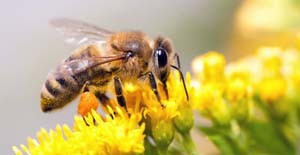Oxford Honey and Supplies dose not offer pollination services to farmers within and surrounding Oxford County. If you are needing one or more hives on your farm give us a call, we can help you connect with a beekeeper in your aria.
What are the benefits of pollination?
Pollination is the process by which pollen grains are transported from one flower to another (on the same plant or on different plants of the same species). Flowers require pollen from other flowers in order to produce seeds or other plant material necessary for reproductive purposes.
Why use honeybees for pollination?
Although pollination occurs with the help of other insects, animals, wind, water, and gravity, honeybees play an important role. Honeybees pollinate one sixth of the world’s flowering plant species, including hundreds of varieties of agricultural crops including apples, strawberries, carrots, onions and tomatoes. They are also responsible for pollinating many forage plants grown to feed livestock.
Honeybees are the most common insect group used for agricultural pollination because a) they are easily available in large numbers, and b) they have been studied intensively and extensively compared to most other insects. Bees are particularly good pollinators because they require large quantities of nectar, their body size enables them to pollenate flowers of varying shapes, and they tend to concentrate on one plant species at a time – increasing the likelihood that pollination will occur.
Promoting effective bee pollination is important in a farming context because it has been shown to significantly increase crop yields. Honeybees can also provide the same ecological services outside an agricultural context; many native herbaceous plants and several trees species in Canada (including Poplar and Willow) benefit greatly from pollination by honeybees.
How do I decide where to put my hives?
Although hives are best placed in a sunny area, it is important that this area is protected and undisturbed. Be sure to protect hives from high winds. Tree lines or on the edge of a wooded area may be ideal. Placing hives in an area with a diversity of pollen-rich plants will increase overall honey yield.
